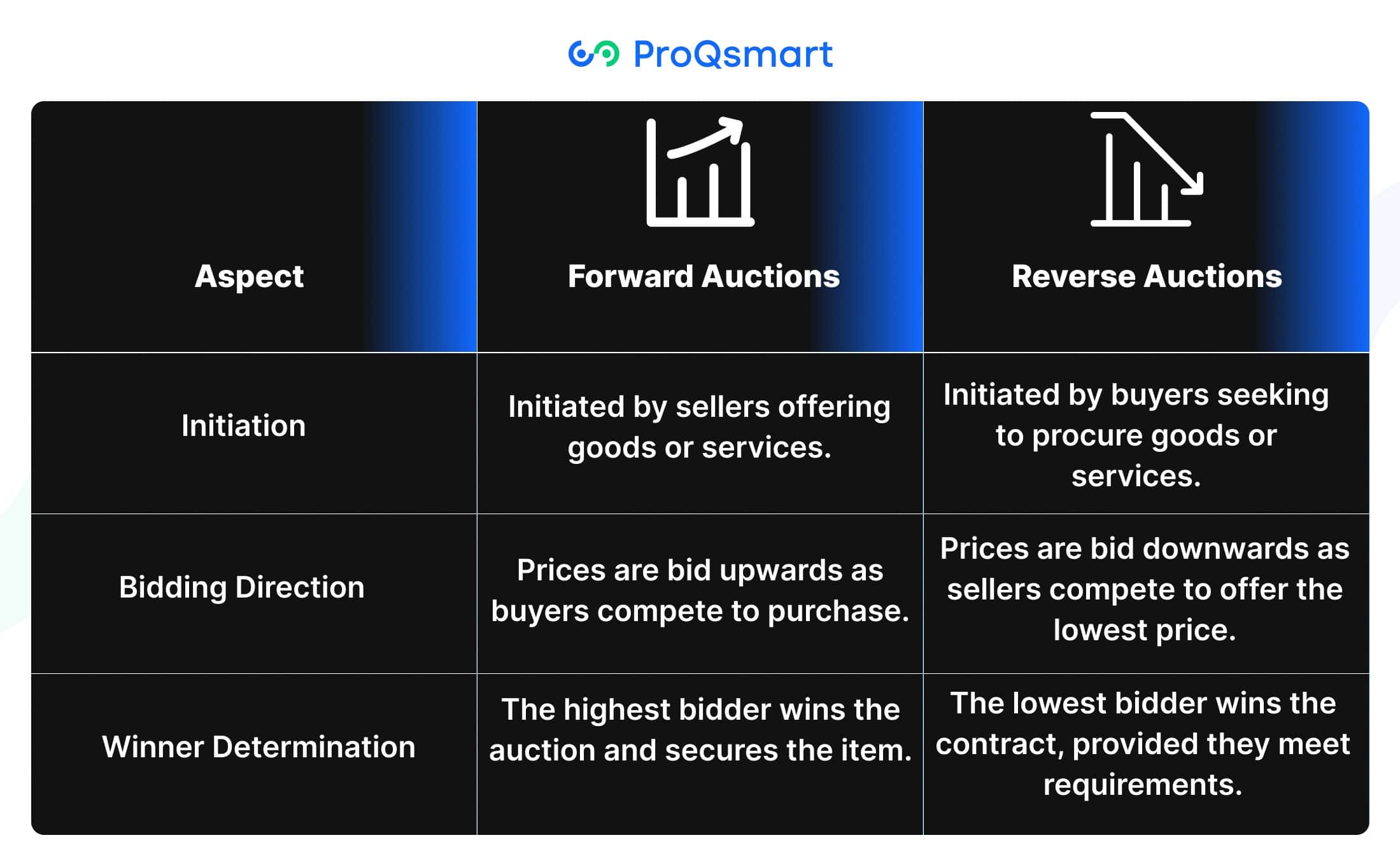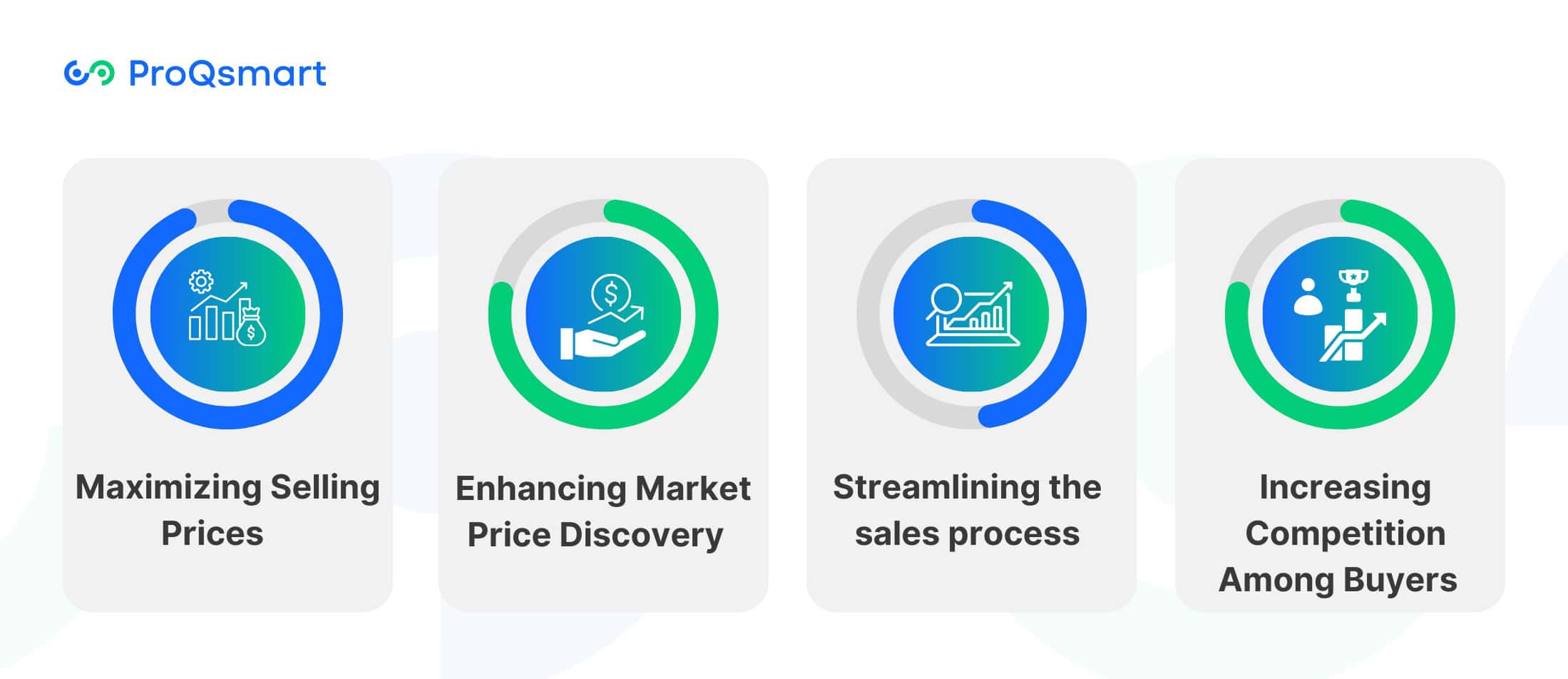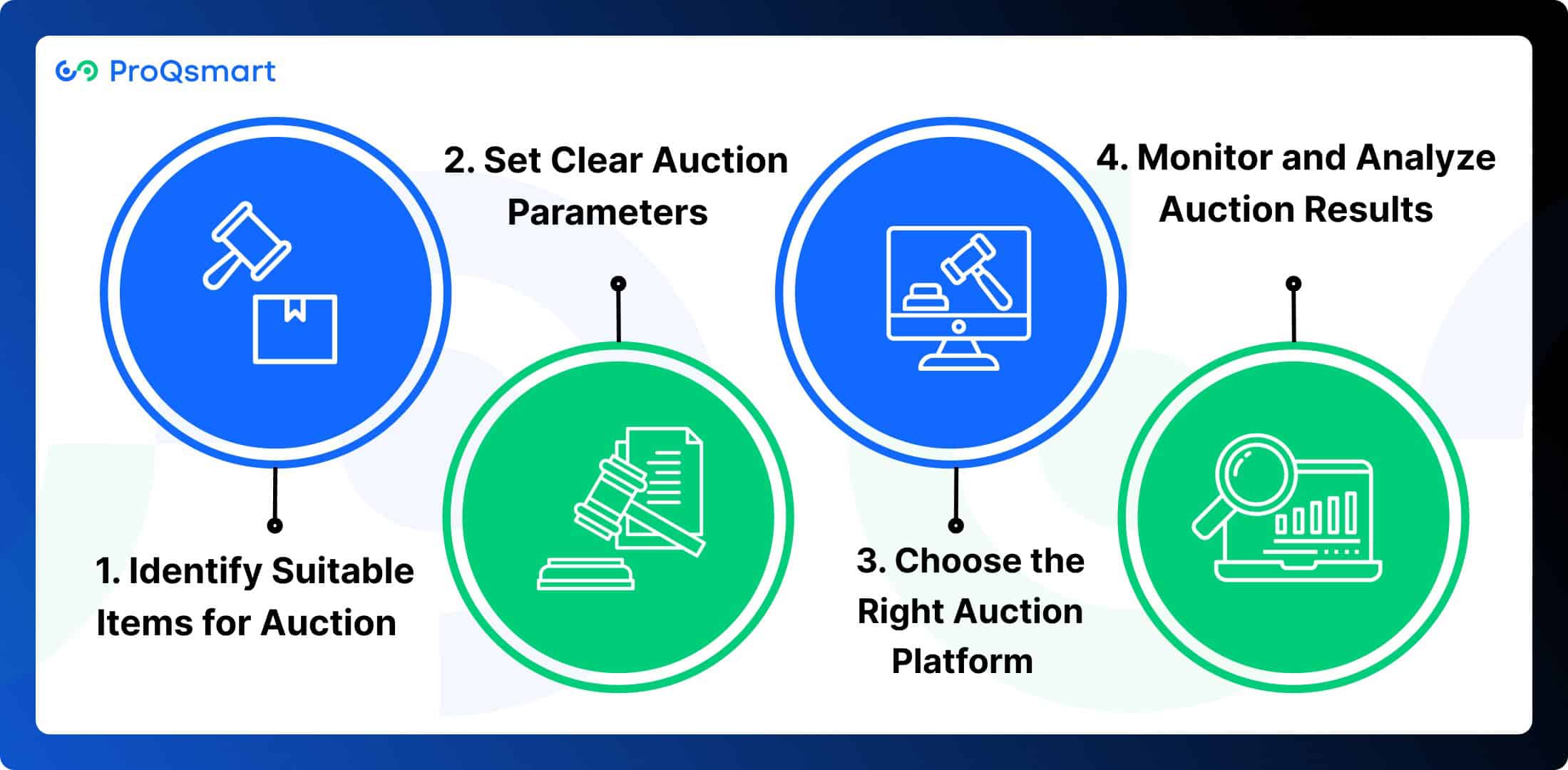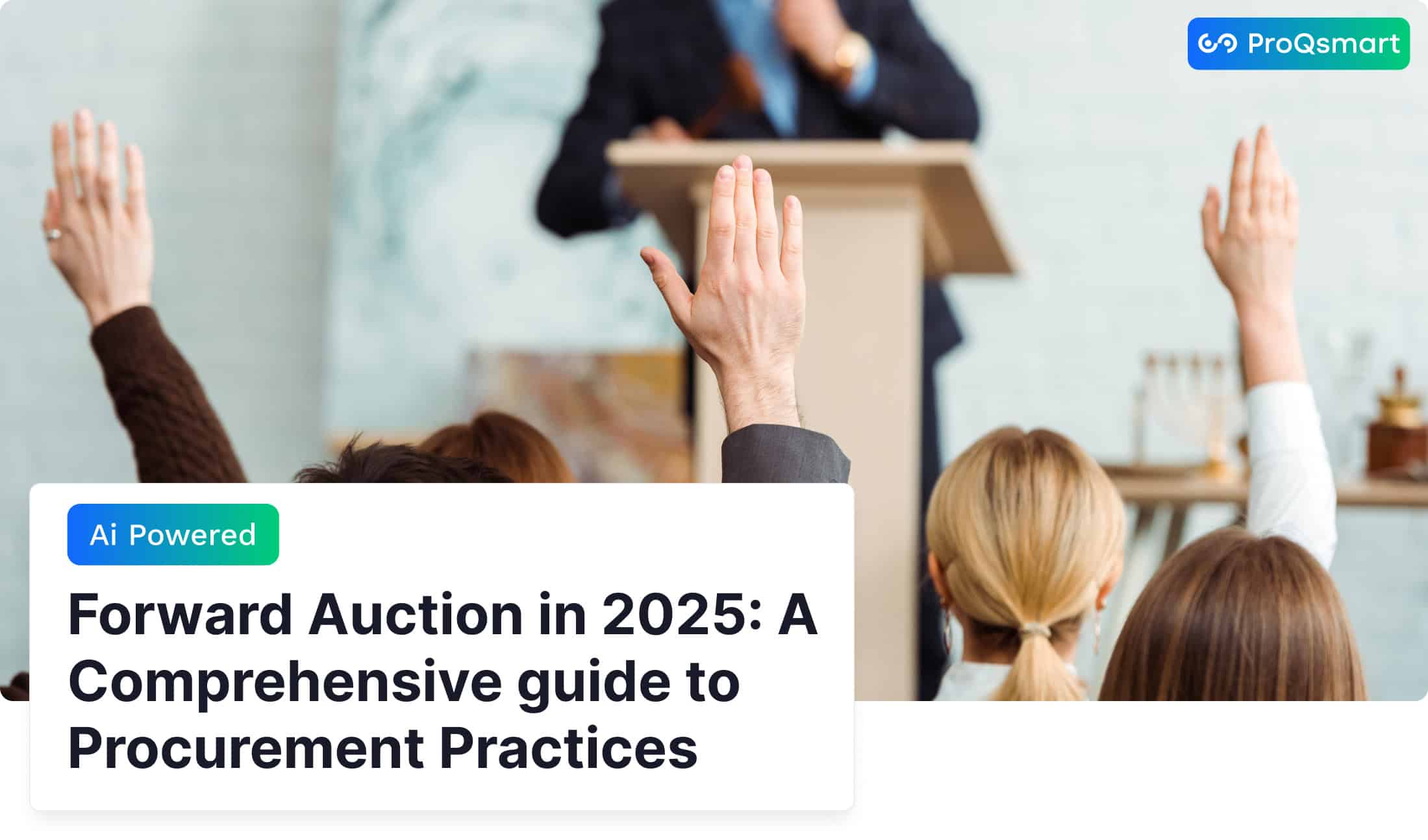Forward auctions provide a cost-effective, competitive, and transparent process for acquiring goods or services. They’re an important component of today’s procurement environment.
These auctions allow sellers to present their offerings while buyers bid against one another, often leading to better pricing and value. With advances in technology, online platforms have made this process far more approachable and efficient for businesses.
Public and private sector enterprises benefit from better cost control and an expanded supplier base. They work best in sectors such as manufacturing and construction, where the purchase of bulk goods is more feasible.
It also increase competition and create certainty. This alone has saved organizations millions of dollars and allows them to optimize their procurement strategies and confidently meet operational goals.
What Is Forward Auction
In a forward auction, a single seller offers an item for sale. Those multiple buyers then compete by bidding against each other to acquire the item. The goal is straightforward: buyers compete to outbid each other, driving the price upward.
The forward auction process starts with a seller-defined reserve price. After that, players continue raising their bids until only the highest bidder wins the item. The seller’s interest is served by maximizing the final sale price.
How Forward Auctions Work
The process of a forward auction unfolds in clear steps:
The seller posts the item with clear descriptions and specifications.
Potential buyers are alerted via online advertising or print media.
Buyers place bids, usually using online clearinghouse tools that allow for one-click bidding or mobile bidding.
Bidding Increments: Each new bid has to be higher than the last by a specified minimum amount, providing continuous upward price movement.
Auction Duration: A set time frame dictates the auction’s length, influencing buyer participation based on urgency.
Instead, the highest bidder wins, and that’s that—transaction completed.
Newer platforms such as ProQsmart make this process even easier. They replace manual, error-prone processes, manage thousands of items and participants, and deliver efficiency rates of up to 99%.
Differences Between Forward and Reverse Auctions

Aspect | Forward Auctions | |
Initiation | Initiated by sellers offering goods or services. | Initiated by buyers seeking to procure goods or services. |
Bidding Direction | Prices are bid upwards as buyers compete to purchase. | Prices are bid downwards as sellers compete to offer the lowest price. |
Winner Determination | The highest bidder wins the auction and secures the item. | The lowest bidder wins the contract, provided they meet requirements. |
Benefits of Forward Auctions in Procurement

Maximizing Selling Prices
Forward auctions provide sellers with a dynamic mechanism to maximize selling prices through competitive bidding. By utilizing auction software, sellers can set a minimum bid or reserve price to ensure they receive a satisfactory value for their items, encouraging bidders to compete aggressively. The competitive environment amplifies psychological factors, such as the fear of missing out, prompting buyers to outbid one another and drive prices higher. Effective marketing to the right bidders, such as advertising through industry-specific channels, is also crucial for complete success. For example, a manufacturing company successfully auctioned excess equipment, resulting in fierce competition that significantly increased the sale price.
Enhancing Market Price Discovery
By offering a better understanding of demand in the marketplace, forward auctions do a better job of improving price discovery. Competitive bidding reflects the true value of goods or services, offering sellers and buyers a transparent view of the market.
For sellers, this increased transparency provides more confidence in fair pricing, and buyers benefit from increased confidence that the process is legitimate. New analytics tools make this even better by scoring bidding patterns and trends.
For example, an organization using these tools might notice peak bidding activity at specific times, helping to strategically plan future auctions. This data-driven approach adds a layer of transparency and ultimately leads to more impactful strategies to advance long-term procurement objectives.
Streamlining the Sales Process
While traditional sales negotiations can be costly in resources and time, forward auctions reduce these costs significantly as we automate many processes through software. Finally, sellers experience less administrative burdens with processes and timelines clearly laid out to offer a smooth process from start to finish.
Clear schedules allow for proper buyer planning, saving even more time on avoidable delays. For instance, construction companies are using forward auctions to win multi-year supply contracts, reducing the time involved and realizing more cost-effective results.
Increasing Competition Among Buyers
Forward auctions thrive in competitive environments where multiple buyers actively bid against each other, creating a sense of urgency that drives up final sale prices. Real-time updates during the auction keep participants engaged, enhancing the competitive dynamic.
This approach is particularly beneficial for selling high-value or complex items, as it offers transparency and ensures that all buyers are aware of the competitive landscape. Sellers benefit from increased demand and improved financial performance, as the competitive bidding process often leads to higher sale prices than initially anticipated. Effective marketing strategies, such as targeted advertising, are essential to attract the right bidders and maximize interest.
How to Implement Forward Auctions Effectively

1. Identify Suitable Items for Auction
The success of forward auctions in construction and manufacturing hinges on selecting items that meet specific criteria: high demand, uniqueness, and clear value to potential buyers. A solid understanding of market demand is essential.
Items such as specialized machinery, surplus equipment, or unique industrial tools tend to attract competitive bids. Buyers in these sectors are often willing to pay premium prices for distinct products that enhance their operations. When sellers align their offerings with buyer interests, they create a compelling incentive for bidders to compete vigorously against one another, ultimately driving up sale prices and ensuring a successful auction outcome.
2. Set Clear Auction Parameters
Having clearly defined auction rules from the beginning minimizes auction disruption and fosters trust among bidders. Important parameters such as bidding increments, auction length, and reserve prices should be carefully considered.
For instance, a reserve price protects against underselling by establishing a minimum acceptable bid. Transparency is just as important—make sure that starting prices, time limits, and conditions are clearly spelled out to all participants.
Draft a checklist of auction parameters. Things such as setting minimum bid prices, determining auction length, and making sure it’s compatible with automated purchases like purchase order creation.
3. Choose the Right Auction Platform
For forward auctions, there are very specific needs. Choose software that’s easy to use, including features such as secure payment gateways, mobile access, and real-time bidding capabilities.
Advanced tools provide for more visible supplier engagement and automates much of the process. Platforms like ProQsmart come equipped with the specialized tools to help you thrive.
Connecting them with other systems like CRMs or payment processors increases efficiency all around.
4. Monitor and Analyze Auction Results
Measuring performance metrics not only measures success but assists in refining strategies. Important indicators are auction bidding patterns, levels of participation and values of the winning bids.
Participant feedback is hugely valuable in telling you how to improve it. Constant analysis will make sure that you’re always optimizing the auction process.
Integrating Forward Auctions into Procurement Strategies
Role in Supplier Selection
Forward auctions serve as a strategic tool for identifying competitive and capable suppliers through a transparent bidding process. Suppliers compete against each other in live auctions, showcasing their bids, which helps procurement teams understand pricing trends and assess supplier viability.
Entities purchasing commodities can leverage forward auctions to compare bids and pricing models from different suppliers, allowing them to evaluate responsiveness and adherence to deadlines. The auction results provide valuable data for establishing long-term partnerships with suppliers.
Through this competitive dynamic, procurement teams can gauge supplier performance, gaining insights into reliability, cost-effectiveness, and adaptability before future negotiations. This approach not only saves costs but also fosters a culture of regular supplier engagement, enhancing overall procurement effectiveness.
Supporting Contract Management
Because forward auctions create a commonly understood price benchmark, they can simplify and explain the contract negotiation process. The auction’s competitive nature guarantees that the best pricing is transparent and fair, avoiding the pitfalls of ambiguity found in traditional negotiation. For example, auction results produce written benchmarks that make renewing contracts easier in the future.
Companies on the receiving end of that money who use tools like ProQsmart can easily fold auction results into existing contract management workflows. ProQsmart’s AI-driven features, including supplier performance monitoring and regulatory compliance tracking, further improve the post-auction contract process.
One construction company was able to leverage forward auctions to procure contracts on raw materials. This innovative strategy produced not only a 7% cost saving but created compliance and auditability.
Aligning with Organizational Goals
Forward auction strategies should be integrated into larger business goals. If done successfully, auctions drive greater revenue growth through better procurement cost efficiencies and stronger supplier partnerships. Conducting evaluations on a regular basis helps make sure these strategies are responsive to shifting market conditions.
For example, companies leveraging ProQsmart have realized cost savings and have pulled procurement activities more in line with budgetary targets, improving their position in the market.
Leveraging Technology for Seamless Integration
Technology has made forward auctions an important tool in procurement strategies. Advanced software solutions, such as ProQsmart, maximize efficiency with capabilities, including real-time collaboration, e-tender management, and transparent bidding processes.
These features greatly enhance transparency and communications between participants, as well as more informed decision-making. The businesses that have adopted ProQsmart have seen smoother auctions, more savings, improved supplier engagement.
Challenges in Forward Auctions and Solutions
Managing Buyer Participation
One of the most serious problems forward auctions can encounter is a lack of active buyers. Less participation can undermine competition and affect the outcome. This is where smart and effective marketing comes into play.
Sellers can help themselves by utilizing online campaigns, email outreach, and targeted advertising to cast a wider net and generate interest. Clear auction information, including item descriptions, bidding schedules and procedures, and terms of sale build integrity and increase buyer confidence.
To encourage greater participation, think about how you can provide incentives to participate. Discounts on upcoming auctions, or even access to exclusive events for free, go a long way!
Tactics to increase buyer engagement include:
Running social media promotions targeting key demographics
Offering early registration perks
Creating detailed buyer guides to simplify the bidding process
Leveraging testimonials or success stories from past auctions
Ensuring Transparency and Fairness
Transparency fosters trust, and equitable treatment levels the playing field for all bidders. Transparency in the auction process, including clear auction rules and open communication with bidders, is key.
For example, rules should clearly outline acceptable bid increments and what behavior will be considered disruptive. Monitoring auction activities to flag possible fraud, such as fake bids, is just as necessary.
Adopting best practices, like using auction platforms that allow real-time tracking of bids, brings transparency to the process for everyone involved. Elements such as open supplier participation and sophisticated e-auction techniques ensure continued credibility.
For example, ProQsmart removes opportunities for human error, thus increasing fairness even more.
Addressing Technical Issues
Technical glitches can tank even the best-planned auctions, and leave potential winners angry and disappointed. From platform crashes to login troubles, these obstacles require strong backup plans.
Risks are minimized with reliable auction platforms that offer features like one-click bidding, mobile access, and more. The customer support piece is really important.
Immediate answers and on-the-ground support during auctions keep things running like clockwork. Choosing software that’s fully integrated with your existing CRM or payment processing systems can further reduce any potential hiccups.
Overcoming Resistance to Change
Many organizations are simply averse to adopting forward auctions because they haven’t done it before. Educating stakeholders via workshops and applicable case studies will be key.
Focusing on positive impacts such as greater efficiency in decision-making processes and reduced costs helps change the narrative. Showcasing successful outcomes creates trust and generates acceptance, paving the way for forward auctions to become a go-to solution.
Future Trends in Forward Auctions for 2025
Innovations in Auction Technology
Recent technological advancements are transforming forward auctions, enhancing efficiency and precision in procurement processes. ProQsmart leverages data analytics to optimize auction outcomes, utilizing auction tools to determine optimal pricing based on historical bidding data and market trends. Predictive analytics tools within ProQsmart provide insights into bidder behavior, enabling firms to adapt their strategies during the auction for better results. These innovations are reshaping the forward auction landscape, driving improved outcomes for procurement professionals.
Growing Use of Artificial Intelligence
AI is transforming forward auctions by automating tedious processes and enhancing decision-making. Machine learning algorithms process huge datasets to forecast buyer behavior and recommend effective bidding strategies. For example, AI-powered tools such as ProQsmart’s sourcing technology monitor and report on supplier performance, keeping you compliant and helping you create faster procurement cycles.
AI is used to make online auctions more efficient by predicting demand trends and automating workflows. For instance, AI models could suggest optimal auction timing based on activity in the market, minimizing idle time and maximizing bidder participation.
Increased Focus on Sustainability
Sustainability is quickly becoming one of the cornerstones of forward auctions, with environmentally friendly products taking center stage. That’s the direction auctions are moving in — toward goods such as energy-efficient homes equipped with solar panels, in step with international commitments to lower carbon footprints.
Digital auction technologies are advancing the sustainable sourcing movement by providing cheap and clean alternatives to all bidders. ProQsmart is proud to support these initiatives, equipping procurement professionals with the tools they need to align procurement with sustainability goals.
Capital expenditure sourcing, for instance, allows companies to focus on sourcing greener investments, while still being cost-effective. Success stories include companies that have successfully auctioned low-carbon materials for construction federal projects through forward auctions, blueprints of a green future.
Expanding Global Reach
The global reach of forward auctions is rapidly increasing, thanks to the ease of online platforms. Internet-based systems create opportunities for participants across the country to participate in national or multi-state auctions, further expanding the pool of participants.
Platforms such as ProQsmart make global procurement easier than ever by automating workflows and providing transparency and compliance across jurisdictions. Transparent and efficient auction processes invigorate international markets. They bring in a more diverse pool of bidders to industries like real estate and capital improvement projects.
Conclusion
Forward auctions are a new, innovative strategy to the procurement game. They provide better transparency in pricing, enhanced competition among suppliers, and opportunity to realize savings. When armed with the right tools and strategies, they align seamlessly with your procurement priorities. Issues such as bidder engagement or tech adoption are surmountable with thoughtful planning and assistance.
Looking ahead to 2025, forward auctions will be able to take advantage of more advanced technologies and better data-driven insights. The only way to stay ahead is to pay attention to these trends and adjust accordingly.
Interested in enhancing procurement processes? Book a demo with ProQsmart today! Discover how the advanced platform can streamline forward auctions, optimize supplier engagement, and improve overall efficiency. Experience firsthand the powerful features that create new value for your organization.
FAQs
What is a forward auction?
A forward auction is an electronic, competitive, and open bidding process where sellers offer items or services for sale, and buyers engage in active bidding to bid up the price. In this auction type, the highest bidder wins the item, making it a popular choice in procurement and e-commerce.
How do forward auctions benefit procurement?
Forward auctions save taxpayers’ dollars by driving down costs through robust competition among qualified businesses. These auction tools promote transparency and create efficiency in the procurement process, ensuring competitive pricing that maximizes value for pain-buying buyers and gain-selling sellers.
What industries commonly use forward auctions?
Forward auctions are widely utilized in various industries, including manufacturing and retail, for disposing of surplus inventory and excess raw materials, showcasing the effectiveness of forward auction software in government procurement.
What are the key challenges in forward auctions?
Challenges abound, including inadequate bidder participation in online marketplaces, technical difficulties with auction software, and worries about bidder credibility. Meeting these challenges involves strong technology, transparent communication, and rigorous bidder qualification.
How can I implement forward auctions effectively?
It all starts with choosing the right auction software, such as ProQsmart, to ensure a secure bidding environment. Set clear auction rules, provide participants with the necessary training, and maintain transparency for complete auction success.
Can forward auctions integrate with procurement strategies?
Indeed, forward auction software is a perfect match for the federal government’s procurement strategies, which seek to leverage competitive pricing. When paired with existing systems, they help strengthen supplier relationships and control costs.
What trends will shape forward auctions by 2025?
Look forward to more AI-powered analytics, blockchain for transparency, and mobile-friendly auction software like ProQsmart. These improvements will enhance the efficiency and security of forward auctions, making them more accessible.



